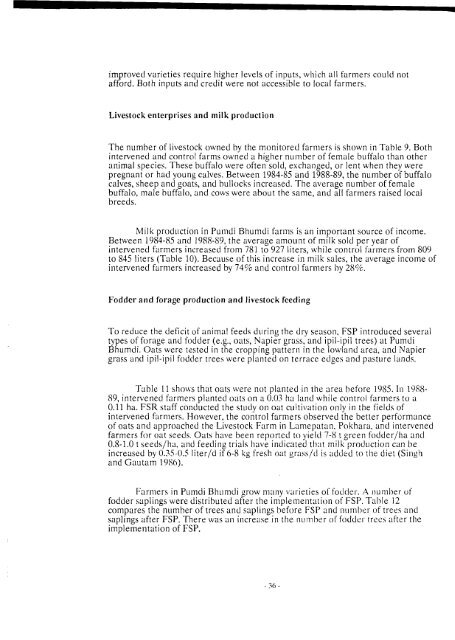systems research - the IDRC Digital Library - International ...
systems research - the IDRC Digital Library - International ...
systems research - the IDRC Digital Library - International ...
You also want an ePaper? Increase the reach of your titles
YUMPU automatically turns print PDFs into web optimized ePapers that Google loves.
improved varieties require higher levels of inputs, \vIiich all farmers could not<br />
afford. Both inputs and credit were not accessible to local farmers.<br />
Livestock enterprises and milk production<br />
The number of livestock owned by <strong>the</strong> monitored farniers is shown in Table 9. Both<br />
intervened and control farms owned a higher number of female buffalo than o<strong>the</strong>r<br />
animal species. These buffalo were often sold, exchanged, or lent when <strong>the</strong>y were<br />
pregnant or had young calves. Between 1984-85 and 1988-89, <strong>the</strong> number of buffalo<br />
calves, sheep and goats, and bullocks increased. The average number of female<br />
buffrllo, male buffalo, and co\vs were about <strong>the</strong> same, and all farmers raised local<br />
breeds.<br />
Milk production in Pumdi Bhumdi farms is an important source of income.<br />
Between 1984-85 and 1988-89, <strong>the</strong> average amount of milk sold per year of<br />
intervened farmers increased from 781 to 927 liters, while control farmers from 809<br />
to 845 liters (Table 10). Because of this increase in milk sales, <strong>the</strong> average income of<br />
intervened farmers increased by 74% and control farmers by 28%.<br />
Fodder and forage production and livestock feeding<br />
To reduce <strong>the</strong> deficit of animal feeds during <strong>the</strong> dry season, FSP introduced several<br />
types of forage and fodder (e.g., oats, Napier grass, and ipil-ipil trees) at Pumdi<br />
Bhumdi. Oats were tested in <strong>the</strong> cropping pattern in <strong>the</strong> lowland area, and Napier<br />
grass and ipil-ipil fodder trees were planted on terrace edges and pasture lands.<br />
Table l1 sho~~s that oats were not planted in <strong>the</strong> area before 1985. In 1988-<br />
89, intervened farmers planted oats on a 0.03 ha land while control farmers to a<br />
0.11 ha. FSR staff conducted <strong>the</strong> study on oat cultivation only in <strong>the</strong> fields of<br />
intervened farniers. However, <strong>the</strong> control farmers observed <strong>the</strong> better performance<br />
of oats and approached <strong>the</strong> Livestock Farm in Lamepatan, Pokhara, and intervened<br />
farmers for oat seeds. Oats have been reported to yield 7-8 t green fodder/ha and<br />
0.8-1.0 t seeds/ha, and feecling trials have indic:ited th:it milk production can be<br />
increased by 0.35-0.5 liter/d if 6-8 kg fresh oat grass/d is added to <strong>the</strong> diet (Si~lgh<br />
and Gautam 1980).<br />
Farmers in Pumdi Bhumdi grow many varieties of fod(lsr. A numher uf<br />
fodder saplings were distributed after <strong>the</strong> implementation of FSP. Table 13,<br />
compares <strong>the</strong> number of trees and saplings before FSP and n~~ml~cr of trees and<br />
saplings after FSP. There was an increase in <strong>the</strong> n~!rnber of fuddcr trees after <strong>the</strong><br />
implementation of FSP.
















